Diseases and disorders of indoor growing
Learning to identify the signs and symptoms of common diseases and disorders found in indoor gardens will help to prevent spread or crop loss.
Common Diseases and Physiological Disorders
The best way to prevent and control disease in indoor garden is to restore your garden to ideal growing conditions. Once diseases are established, it can be difficult to eradicate! Check the diseases below to determine what course of action you might take to help your garden ward off problems.
Damping Off
Symptoms
Poor germination or germinated seedlings whose stem narrows and turns brown at the soil level resulting
in collapsed seedlings. It tends to move in a circular spreading pattern moving from one plant outwards to infect the rest, often wiping out a whole tray of seedlings very shortly after appearing.
Causes
Damping off is caused by a variety of different pathogens found in the environment and usually refers to the rotting of seedlings below the soil surface. In most cases, infected plants will germinate and come up fine, but within a few days they become water-soaked and mushy, fall over at the base and die. Damping off typically occurs when older seed is planted in cold, wet soil with poor drainage. High humidity levels can also encourage its growth.
Control
There is no cure for plants already damping off. Remove the infected plants. Sterilize trays. Replace potting soil. Be sure not to fertilize seedlings until they reach ‘true leaf’ stage.
Prevention
You can prevent damping off with a few tips:
Grow seedlings in warm soil and airEnsure you are using clean seed
Control over watering and avoid watering in the evening
Provide adequate air movement around transplants
Remove your plastic cover from seed trays immediately after seeds germinate.
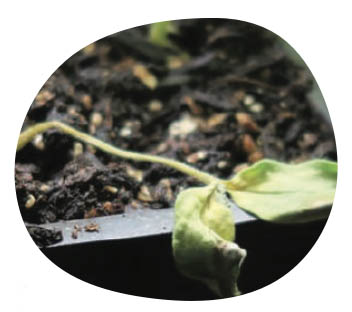
Verticillium
Symptoms
Plant leaves will begin to droop, turn yellow or brown, and begin to fall.
Causes
Verticillium wilt is a fungal disease of many garden plants including trees and shrubs but is most severe in the potato and tomato family. The fungus usually enters via roots, plugs the water moving tissues result in in sudden and permanent wilt in the plant. It damages leaves, stems and the fruit of the plant.
Control
Remove affected plant material immediately and dispose of your soil. You will want to sterilize your growing container before reuse.
Prevention
Ensure that you are not re-using soil for similar crops. In our LGT garden you should use fresh soil each year! Make sure that soil is well drained. Ensure growing containers are sterilized each year before use.
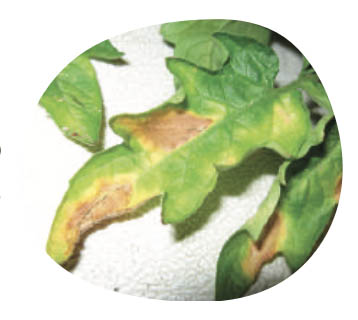
Fungal and Bacterial Leaf Spot
Symptoms
Infected plants have brown or black water-soaked spots on the foliage, sometimes with a yellow halo, usually uniform in size. The spots enlarge and will run together under wet conditions. Under dry conditions the spots have a speckled appearance. As spots become more numerous, entire leaves may yellow, wither and drop.
Causes
Leaf spot is a pathogen-caused fungal leaf spot. Leaf Spot is most active when there is plenty of moisture and warm temperatures.
Control
There is no cure for plants infected. You will want to discard any affected plant materials. Make sure to always disinfect your pruning equipment (one-part bleach to four-parts water) after each cut. Correct the water moisture levels and use an oscillating fan to promote air circulation.
Prevention
Prune or stake plants to encourage air circulation or use an oscillating fan. Ensure moisture levels are not too high. Try not to water from above.


Blossom End Rot
Symptoms
A water-soaked spot at the bottom end of tomato fruits is the classic symptom. It is most common in tomatoes, but can occur in peppers, cucumbers and squash.
Causes
This is a physiological disorder caused by a calcium imbalance within the plant. It is most common when watering is erratic, very wet followed by dry spells. Several factors limit a plant’s ability to absorb calcium, such as soil moisture, excess nitrogen in the soil, root damage due to cultivation, soil PH that is too high or low, or cold soils.
Control
Remove the infected fruits. Usually the problem will correct itself if moisture is kept consistent.
Prevention
We add lime to our Earthboxes, in part to add calcium to our potting soil to prevent blossom end rot. You will want to ensure moisture levels are kept even and that too much nitrogen fertilizer is not applied to the soil.

Root Rot
Symptoms
Plant growth will become stunted, and then plants will wilt and turn yellow. The leaves start to get dull as the plant dies. You can remove the plant from the soil and feel the roots. Most often roots will look black and may fall from the plant when you touch them. Healthy roots may be black or pale but will feel firm and pliable.
Causes
Root rot is caused by too much water and/or soil-borne pathogens. Prolonged exposure to overwatered conditions can cause some of the roots to die back due to a lack of oxygen. The other cause is a fungus in the soil that will flare up after a few repeated situations of over watering.
Control
Ensure that your soil is not over-saturated and allow soil to dry. Your best bet is usually to discard the infected plant and soil and sterilize the growing containers. Some gardeners treat root rot by removing the plant from soil and washing roots under running water and cutting away affected roots. This is more common with established houseplants.
Prevention
Prune or stake plants to encourage air circulation or use an oscillating fan. Ensure moisture levels are not too high. Try not to water from above.
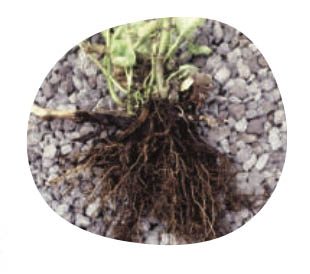
Powdery Mildew
Symptoms
White to gray powdery coating, especially on young leaves. Blistered areas on leaf edges that causes them to curl upward.
Causes
Powdery mildew is caused by a fungus related to downy mildew called Cleistothecia.
What it does
Symptoms include stunted plant growth, leaf drop and chlorosis (the yellowing of plant tissues). Powdery mildew is a disease that shows up most prominently on new leaf growth.
Control
The fungi flourish in highly humid conditions and where there is little ventilation. The dampness of indoor gardens can be ideal for this fungus. Remove infected plants immediately from the garden. Ensure that there is enough room between plants for moisture to evaporate. Use an oscillating fan for a few hours every day to create airflow and keep humidity in check.
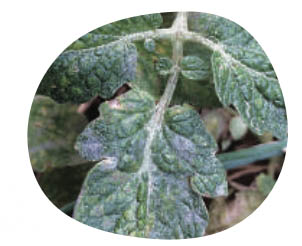
Grey Mold
Symptoms
Grey mold appears as brown patches that eventually become covered in grey or brown fuzzy mold. It is usually found on dead plant materials but may migrate to healthy plants. It is often found near the soil surface or in the densest areas of plant canopy.
Causes
Grey mold is a fungal disease called Botrytis that travels through a garden quickly in damp, cool conditions.
Control
Clean up dead plant debris. There is no control for affected plants, so dispose of all plant materials to prevent further spread.
Prevention
Ensure that soil conditions are not too wet. Always remove weakened and affected plant material from garden and use an oscillating fan to promote air circulation between plants.
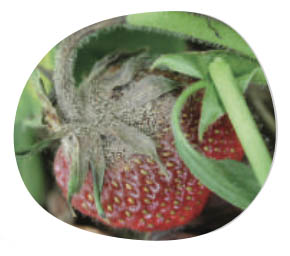
Mosaic Virus
Symptoms
Viral diseases are difficult to identify because symptoms vary from plant to plant and may also vary depending on the age of the plant and its growing conditions. Symptoms also mimic magnesium deficiency, so make sure this isn’t the cause of your plant issue.
The classic symptoms of viruses is mottled foliage or ring-spots. Since viruses circulate internally in the plant, no treatment is effective to rid the plant of the virus. Once a plant is diagnosed with a virus, it is best discarded, as many viruses can infect a wide range of plants.
The following symptoms are most common in mosaic virus:
Plants are often stunted, or they grow poorly.
Causes
This virus infects more than 150 types of plants, including many fruits, vegetables, and flowers. Some of the most commonly infected plants include tomatoes, squashes, cauliflower, and cucumbers.
Cucumber mosaic virus is usually spread by aphids. As can be inferred from its name, cucumber mosaic virus often affects cucumbers, but it is also a common problem for tomatoes, melons, squashes, and other plants.
Tobacco mosaic virus spreads through seeds and direct contact.
Control
Once plants are infected, there are no controls. Remove all the infected plants and destroy them. Also, be sure to disinfect your gardening tools.
Prevention
Cucumber mosaic virus is mainly spread by aphid feeding, so be sure to get on top of any aphid infestations early. Clean and disinfect any garden tools after infection. Always discard infected plant material immediately.
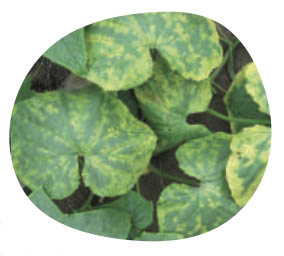
Seedling Mold or Algae
Symptoms
This can present as white, fluffy fungus that grows on the soil of your seedlings, or it may be dry brown or green.
It is easy to confuse fungi or algae for the dry, crusty, white buildup of fertilizer salts that form on top of the soil surface. Though neither of these conditions are harmful, you can loosen the soil around the fertilizer build-up and water thoroughly to flush the salts.
Causes
The white fluffy fungus or brown or green algae growing on your seedlings is usually caused by high humidity or soil that is too wet. The mold is often harmless to your plants but can be a sign that conditions need to be corrected in your garden. Soil that is too wet will eventually hurt seedlings.
Control
Refrain from watering until your seedlings are dry. Ensure that your seedlings are receiving at least 12 hours of light each day. You may even want to increase airflow around your seedlings using an oscillating fan. Once you restore conditions, the fuzz will disappear, or you can simply remove it by scraping it with a knife or spoon.
Prevention
Algae is more likely to form on soils under intense fluorescent light. If your soil is exposed, you can cover with cardboard or other mulch.
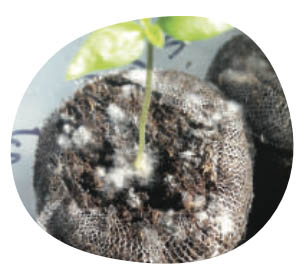 Thanks to Little Green Thumbs for providing the information and images on this page.
Thanks to Little Green Thumbs for providing the information and images on this page.

